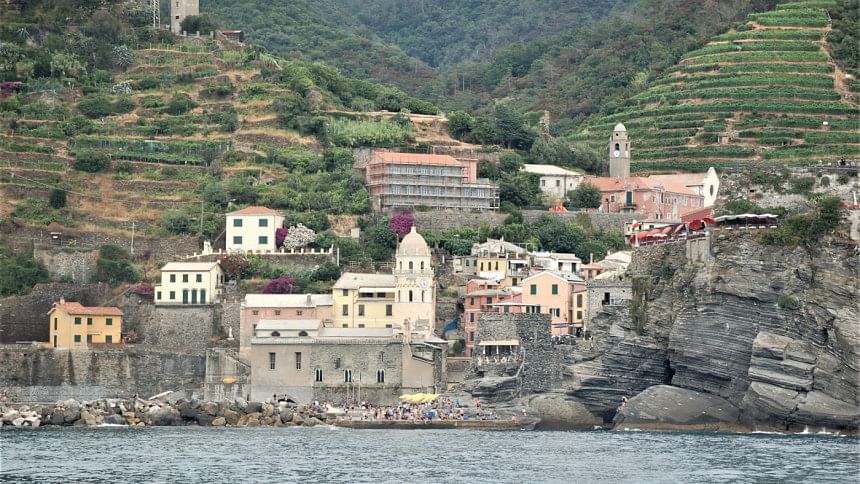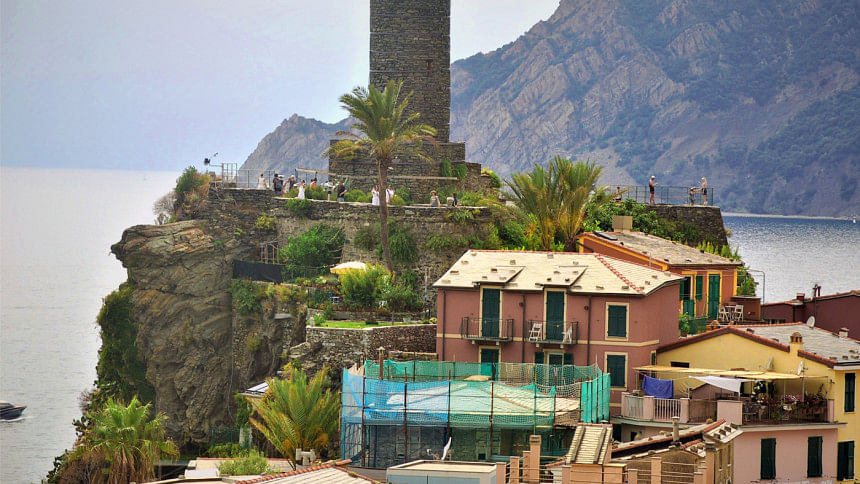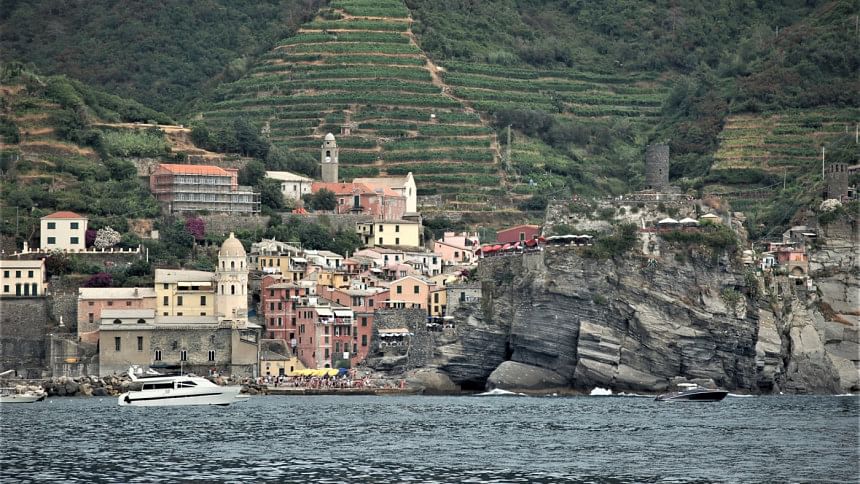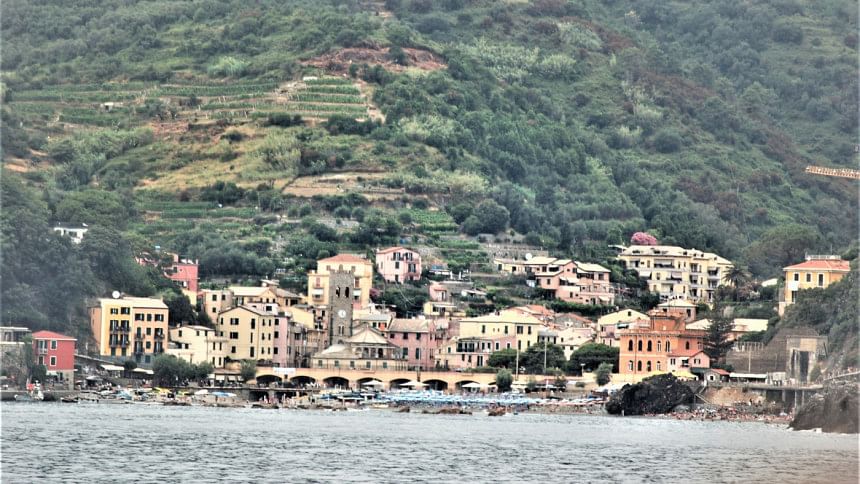Cinque Terre — A tale of sisters

Cinque Terre means 'five villages,' because this band of five picturesque fishing villages are bound by a single thread, as if to tell a collective tale, along the Mediterranean coast of Liguria, Italy.
The pastel, wave-caressed, Alps-corralled Liguria whisked me back to the day when I first fell in love. Splashing of the waves, chirping of the birds, tolling of the church bells, and roar of the fast trains made for a perfect orchestra that came alive in my imagination.
I was at liberty to compose my tunes.
An hour's train ride from Pisa, lies the mountainous region of Liguria. Where Tuscany trails off, Liguria picks up. We had planned to visit two villages — Monterosso Al Mare and Vernazza. As our train crawled in the dark tunnel — pierced periodically by spectacular views — I got a whiff of something special.
It was not until the tunnel finally gave way to a dazzling view of the vast expanse of the blue sea on one side, and the imposing heights of the mountains on the other, that I truly missed a heartbeat. She suddenly unwound herself out of the darkness in a burst of radiance.
I was in awe for a few seconds. When we finally got off, I felt lost in a utopia tucked away from the maddening crowd, nestled in the loving arms of The Alps, soothed by the gentle sea sprays, and pampered in-between by the charming shops, scent of the freshly-caught anchovies, spaghetti with pesto sauce, smattering of wildflowers, and awestruck beholders, as if she were a spoiled child that could never be let go.

She was unique in that she felt detached from the hustle and bustle of big towns, for life here seemed in no hurry to get anywhere. No, she did not boast famous museums, nor the designer shops — not even grandiose architecture — nor did she enjoy the reputation of more illustrious Tuscany, but she had her own lazy charm in an elegant simplicity that creeps into one's heart never to leave.
The station between the tunnels was a small opening, sandwiched between the sea and the mountains. When I looked at the tunnels, it seemed we had emerged like a rabbit out into this wonderland, only to be bewitched. This was Monterosso Al Mare, the northernmost village. What made her more appealing was that she had only 3 taxis, one of which took us through a narrow maze of pedestrian-friendly streets up a winding driveway to the lovely hilltop hotel.
Hotel Villa Steno, a vantage-point atop a hill, offered panoramic views of the village and the sea, punctuated by boats. Adorned by the surrounding trees, this was truly a tranquil setting — a well-managed family run establishment, tastefully decorated with modern amenities. While our room's balcony presented an unobstructed view, it offered privacy because of the hotel's staggered architecture. This is where the noise of the insects merged with the whistle of the wind.
The friendly owner, Matteo, greeted us at the lobby and introduced his affable wife, Carla. We could feel their warmth and personal touch at every step. An open stairway on the side offered another route that guests could take down to the village and back up. This was a lovely stroll through the orchards, replete with home-grown oranges.
Later, during breakfast, we had this delicious jam made from these oranges.

Below, the charm lay in the twisted alleys — lined with souvenir shops and eateries serving fresh focaccias — all leading to a square where the tourists and the locals converged, the former more to take in than to let out.
The Church of San Giovanni Battista, nearby, represents Ligurian Gothic style and sports a unique striped façade as if to match the colourful flora. We stumbled upon a shop owned by a Bangladeshi, eager to relive his memories of Dhaka with us.
What better way to see the villages than from the sea? We boarded one of the boats for Vernazza, the next village. The wide-angle view from the boat exposed two other villages looking like inalienable sisters on their mother's lap.
Vernazza had her own charm with rocky beaches. The pastel houses leaned against the mountain in absolute comfort. One beach had a cave-like entrance strewn with groups of small stones piled on top of another — some precariously balanced — in formations that reminded me of long-lost 'The 7 Stones' game.

We tried to playfully rearrange some, recalling our idyllic childhood. We went inland to the hiking trails through the mountains overlooking the sea. These arteries connecting the villages serve as conduits for sharing neighbours' amusing anecdotes.
As we hiked up the trail, one sign pointed to Corniglia, next village in the quintet. As I surveyed, I longed to be trapped out here — till eternity! Having relished everyday life from the trail, we finally headed back to Monterosso.
In the evening, we lazed around the new and old halves of Monterosso, split by a tunnel. We felt like performers on a lit stage in front of a dark sea of audience, crashing waves its applause. My son joined a local band to play his piano in a street corner frequented by the locals every evening after dinner.
I wish I had been there to be regaled much longer. Unsure if I should have actually shrouded her from the prying eyes so that she would never harbour a frenzied crowd, for she is precious in quietude. Perhaps, she wanted to draw me closer to tell a story, reminding me that the beauty in Tuscany continued here, magnified manifold.
This story is not just hers, but also of her warm people who called us friends. Matteo and Carla remain friends and keep us attached to magical Cinque Terre.

 For all latest news, follow The Daily Star's Google News channel.
For all latest news, follow The Daily Star's Google News channel. 



Comments